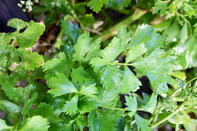
Propagation
Propagation is from celery seed.Planting Method
Celery planting can be done from direct sowing of the seed but most growers prefer to make seedlings and plant these out. Celery seed is very small so sowing evenly is very difficult and the seeds need to be sown very shallowly at about 3 mm to 4 mm. Planting is done by hand or mechanical planter.Spacing
Plants should be spaced 15 cm or 20 cm apart in rows that are 30 cm apart. Depending on the tractor and implement wheel spacing, paths must be left for manual functions and vehicles for spraying and also for harvesting machinery. This is between 100 000 and 150 000 celery plants per hectare depending on the configuration.Sowing Time
Sow celery indoors in seedling trays in July and direct sow seeds into the plant area end of August. Young celery seedlings must not be exposed to late frost as this could kill the young plants. Seedlings are normally ready for planting out at 6 to 8 weeks from sowing.Planting Time
A good time to plant celery seedlings is mid-September when the worst cold is over and frost has passed. This will still give enough time to harvest before the onset of intense summer heat.Growth Period
Celery normally takes between 12 and 16 weeks from when seedlings are planted out into the fields to reach harvest readiness. If direct sowing is done then it will be about four months before the crop will be ready for harvest.Fertilization
Superphosphates are applied and incorporated when the soil is initially prepared and ploughed about 8 weeks before planting. In the final week before planting, a mixture of Nitrogen and Potassium can be applied to the plant rows and disk harrowed into the top 20 cm of soil.
This can be in the form of 500 kg to 750 kg of 1:0:1 (36) and this will give the seedlings the nutrients to settle and boost root development and growth during the first month of growth. Four weeks after planting the celery a further application of 300 kg of 1:0:1 (36) can be applied along the plant row.
After a further four weeks and four weeks prior to harvest, a final application of 300 kg of 1:0:1 (36) can be applied along the celery plant row. Irrigation must follow immediately after each fertilizer application.
The fertilizer applications can also be administered through drip systems by fertigation according to the recommendations provided by the soil analysis.
Irrigation
Irrigation can be in the form of static sprinklers, sprinklers on a pivot system, microjet misters or drip systems on the surface of the rows or in some cases drippers underground along the plant rows.
The day before planting the celery, apply about 20 mm of irrigation to bring the soil to field capacity and immediately after planting about 10 mm to settle the celery seedlings. If direct seeding is done then make sure the topsoil is kept moist with more frequent, lower volume irrigation periods until the seeds have germinated and taken root.
As the seedlings strengthen, longer irrigation periods can commence. Once the plants are settled, the norm is about 25 to 35 mm of irrigation per week. As a result of celery’s shallow root system, it is best to irrigate this crop with two irrigation applications per week.
By Louise Brodie